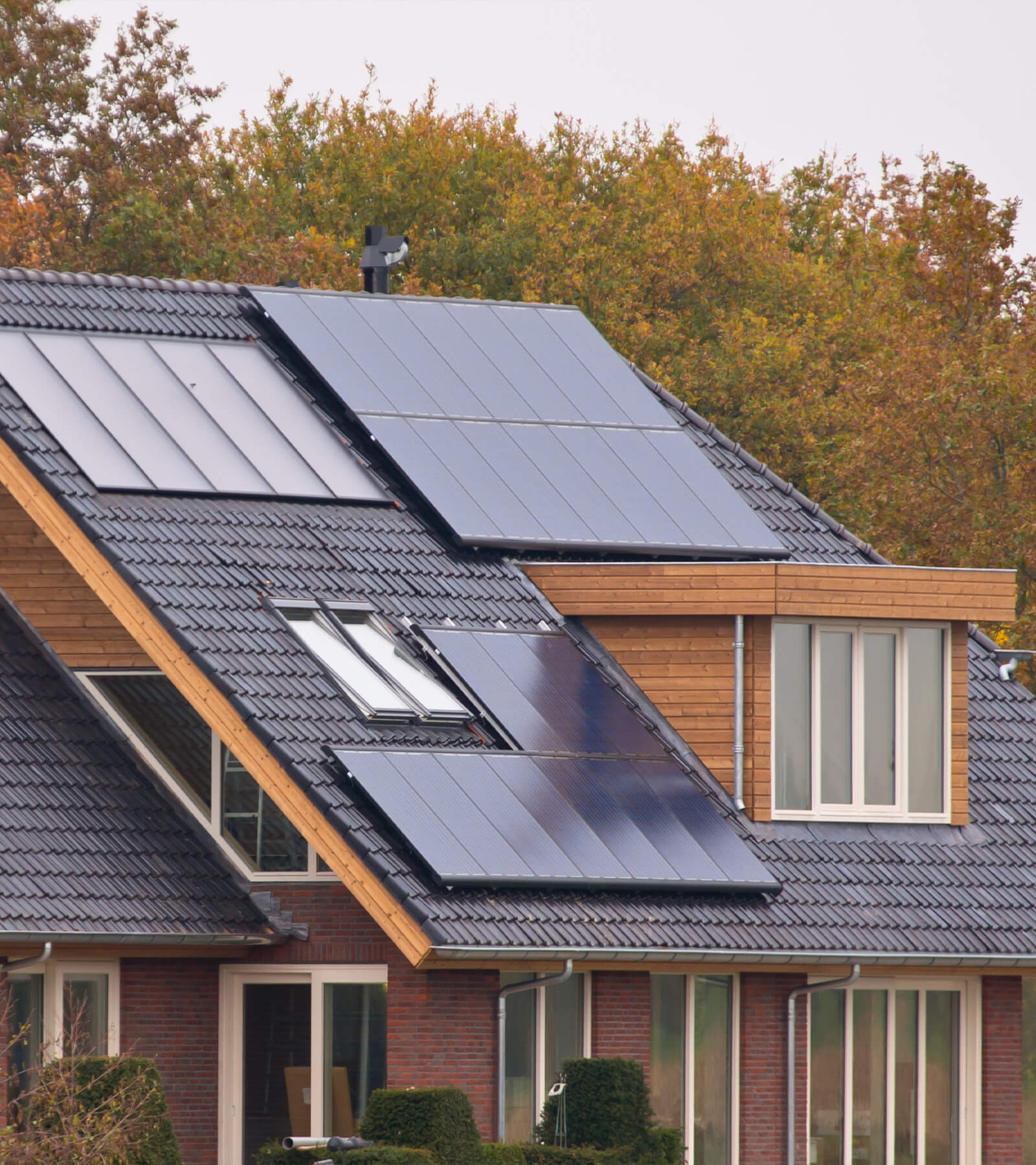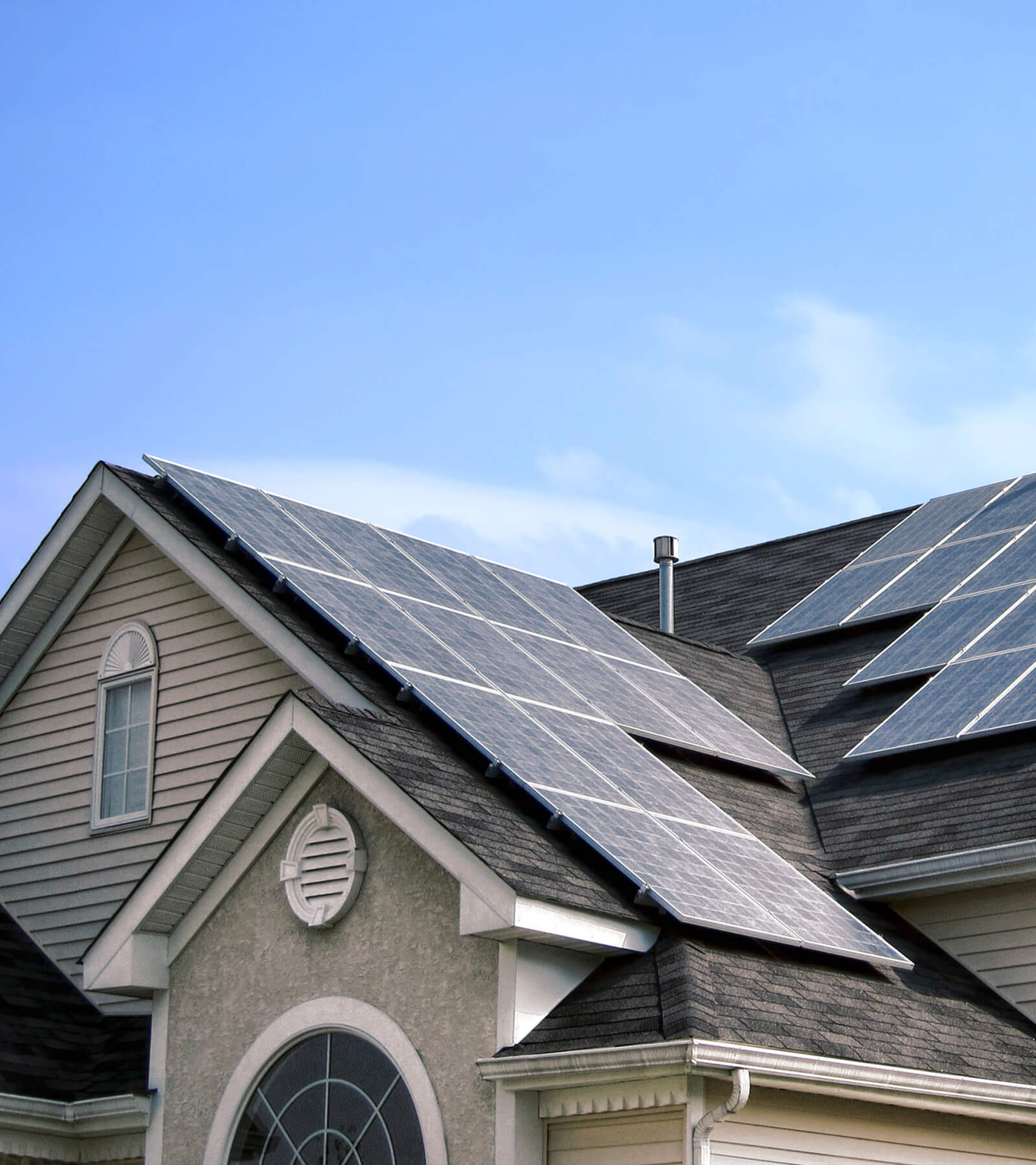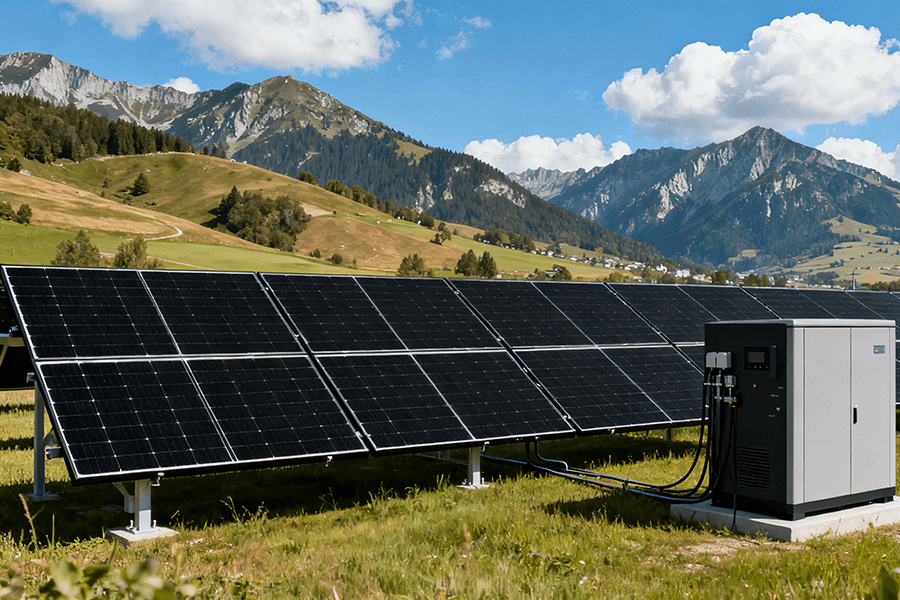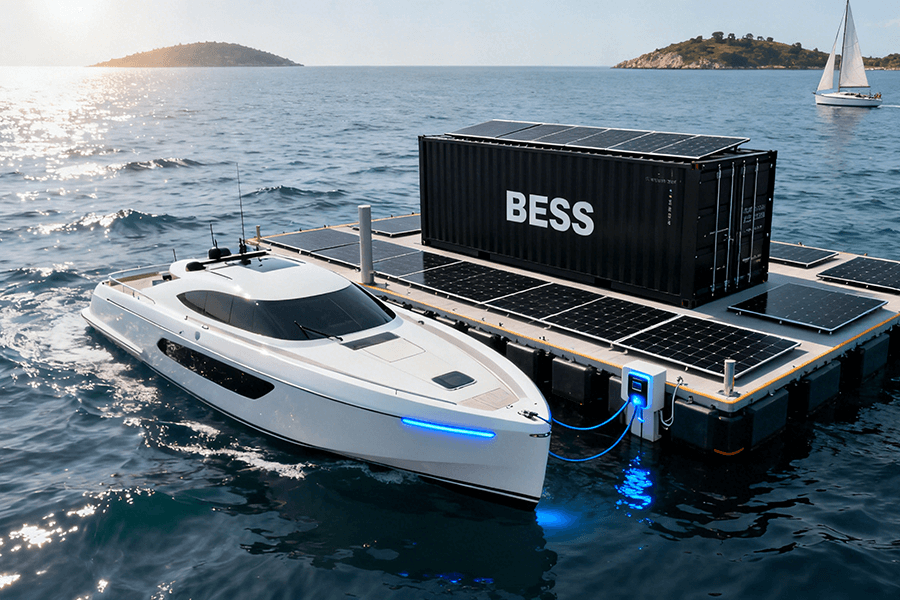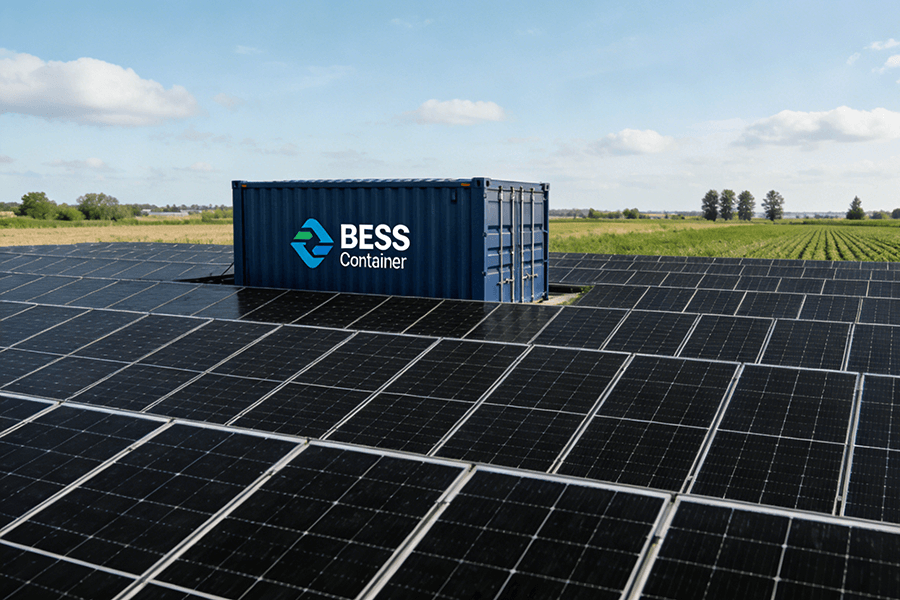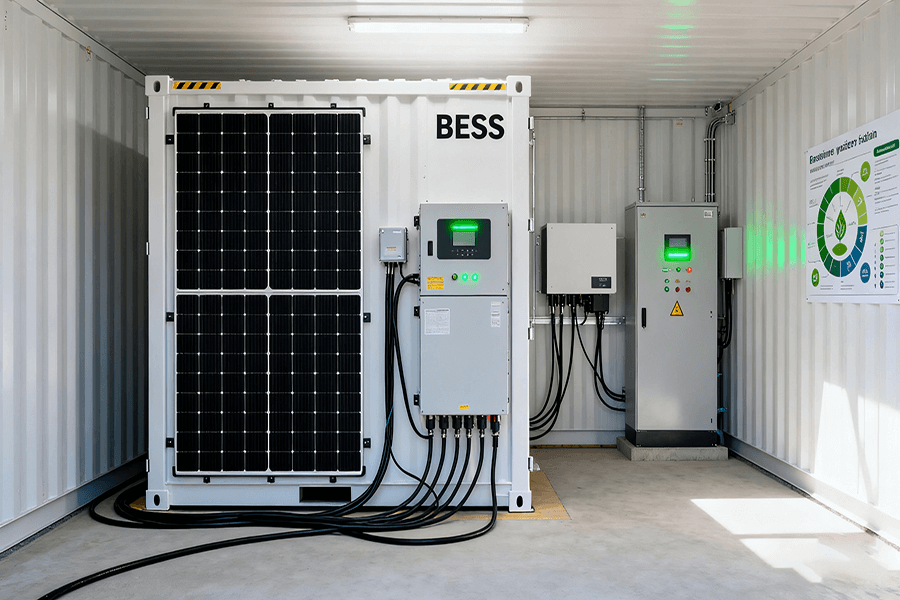
The 2027 EU Mandate – No More Slacking on Solar
By 2027, the EU’s Rural Water Supply Directive will drop a non-negotiable rule: 30% of remote pumping stations’ power must come from renewables. For rural communities and livestock farms (where water is as vital as coffee for early mornings), this isn’t just a “green checkbox”—it’s a call to fix unreliable, diesel-guzzling systems.
Enter BESS Containers (Battery Energy Storage Systems): the unsung heroes that turn solar power’s “sometimes sunny, sometimes not” problem into a steady water supply. Think of them as the “power babysitters” for solar panels—storing excess energy when the sun’s beaming, and doling it out when clouds roll in. No more panic about dry troughs or empty taps.
BESS Container 101: Tough, Efficient, and Diesel-Killing
Not all storage systems are built for the diverse and challenging conditions of rural EU life. Consider the harsh frost that blankets Finland, the sweltering heatwaves that scorch Greece, or the persistent dust that permeates the Spanish countryside. In contrast, BESS Containers are engineered not only to endure but to excel in these environments. Let’s explore their exceptional capabilities in detail:
Power & Durability: Engineered for EU’s Extreme Weather Conditions
These BESS Containers are far more than mere “batteries in a box.” They are robust, high-performance units designed to withstand the rigors of rural life. Below, we’ve compiled a comprehensive table that outlines their key specifications and highlights their compatibility with solar panels, underscoring their suitability for rural EU water pumping stations:
| Spec Category | Range | Why It Matters for Rural EU |
|---|---|---|
| BESS Capacity | 15–40 kWh | Ideal for a wide range of applications, from small villages with around 10 residents to medium-sized livestock farms housing up to 100 heads. This capacity ensures that the pumping needs of various rural setups are met efficiently. |
| Operating Temperature | -25°C to 50°C | Engineered to perform flawlessly in the most extreme climates across the EU. Whether it’s the bone-chilling winters of Lapland, where temperatures can plummet to -25°C, or the sweltering summers of Sicily, reaching up to 50°C, these containers maintain optimal functionality without any degradation in performance. |
| Solar Panel Compatibility | 5–15 kW | In rural areas, most water pumping stations typically utilize solar panels with a capacity ranging from 5–10 kW. The BESS Containers’ compatibility within this range ensures a harmonious integration, preventing issues such as overloading or underpowering and maximizing the efficiency of the overall system. |
| Self-Sufficiency Rate | Up to 75% | With an impressive self-sufficiency rate of up to 75%, these containers significantly reduce reliance on the grid. This means that 75% of the pumping power is derived from renewable sources, such as solar energy stored in the BESS, while only 25% (if required) is drawn from the grid. This not only cuts down on electricity bills but also contributes to a greener and more sustainable rural energy infrastructure. |
One of the most significant advantages of BESS Containers is the elimination of diesel costs. According to research by Renewable Energy Insights, a typical remote water pumping station in the EU spends between €15,000–€30,000 on diesel annually. By adopting BESS Containers, rural communities can completely eliminate this substantial expense, resulting in significant long-term savings and making the switch to renewable energy not only environmentally friendly but also economically beneficial.
Smart Integration: Water Level Sensors for Hassle-Free Operation
The scenario of accidentally leaving a tap running and flooding a kitchen is an inconvenience that many can relate to. Now, imagine the consequences of a malfunctioning water pump in a rural water pumping station. It could lead to significant damage, wasted resources, and costly repairs.
BESS Containers address this concern with their innovative built-in water level sensor integration. This advanced system operates on a sophisticated algorithm that continuously monitors the water level in the tank and automatically adjusts the pump’s runtime accordingly, providing a seamless and worry-free operation:
- Full Tank Scenario: When the tank reaches its maximum capacity, the system immediately pauses the pumping process. This not only prevents overfilling and potential water wastage but also safeguards the battery from overcharging, optimizing energy consumption and extending the battery’s lifespan.
- Low Tank Scenario: Conversely, when the water level in the tank drops below a certain threshold, the system intelligently increases the power output from the solar panels and the BESS to refill the tank promptly. This autonomous operation ensures a consistent water supply without the need for manual intervention, saving time and effort for the operators.
In essence, the BESS Containers’ smart integration features act as a self-regulating system, taking the guesswork out of water management. Rural communities no longer have to worry about making late-night trips to the pumping station to address issues like overflowing tanks, allowing them to focus on other essential aspects of their daily operations.
Compliance: Safe for Drinking Water (No Contamination Risks)
For rural EU communities, drinking water safety isn’t merely a priority—it’s an inviolable principle. These communities rely on their water systems not just for basic hydration, but as the cornerstone of public health and daily life. The prospect of a “green upgrade” inadvertently compromising the integrity of their tap water looms large, with concerns ranging from potential chemical leaching to long-term material degradation.
Regulatory Compliance and Material Assurance
The BESS Container emerges as a solution that seamlessly marries sustainability with safety. It adheres rigorously to the EU’s Drinking Water Directive (98/83/EC), a comprehensive legislative framework designed to safeguard the quality of water intended for human consumption. This directive mandates strict limits on contaminants, sets hygiene standards, and requires continuous monitoring of water quality. The BESS Container’s design and materials have been meticulously engineered to meet and exceed these requirements, ensuring compliance at every stage of operation.
Key Material Attributes:
| Attribute | Description |
|---|---|
| Food-Grade Insulation | Constructed from materials certified safe for food contact, such as FDA-approved polyethylene and BPA-free polymers. These materials have undergone extensive testing to ensure zero chemical transfer to water, even under prolonged exposure or extreme temperatures. |
| Corrosion-Resistant Metals | Utilizes high-grade alloys like stainless steel 316 and titanium, engineered to withstand environmental exposure without degradation. These metals are resistant to rust, chemical corrosion, and biological fouling, ensuring long-term system integrity and minimizing maintenance requirements. |
| Seal Integrity | Incorporates advanced gasket and sealing technologies, including double O-ring seals and hermetic closures. These seals prevent any cross-contamination between the BESS components and the water system, creating a physical barrier that protects water quality from external pollutants. |
Certification and Risk Mitigation
The EU Water Quality Authority has conducted comprehensive, multi-phase testing on the BESS Container, subjecting it to a battery of assessments designed to simulate real-world conditions:
- Leachate Analysis: Evaluates potential chemical runoff under various operational conditions, including high temperatures, pH fluctuations, and mechanical stress. Samples are analyzed for over 200 contaminants, ensuring that no harmful substances leach into the water supply.
- Long-Term Exposure Tests: Monitors material stability over extended periods of use, with prototypes operating continuously for up to 5 years. This testing verifies that materials maintain their integrity and do not degrade over time, even in harsh environments.
- Environmental Stress Testing: Assesses performance in extreme conditions, including temperatures ranging from -40°C to 80°C, 95% humidity, and seismic activity equivalent to magnitude 7.0 earthquakes. These tests ensure the BESS Container remains fully functional and watertight under the most challenging circumstances.
As a result of these evaluations, the Authority has issued a formal certification, confirming that BESS operation presents zero contamination risks to water sources. This certification not only provides peace of mind to rural communities but also validates the BESS Container as a reliable and safe solution for renewable water access. With this assurance, residents can enjoy their tap water with complete confidence, knowing that their water quality remains uncompromised by the integration of advanced energy storage technology.
Sizing Guide: Pick the Right BESS (No Guesswork)
Choosing a Battery Energy Storage System (BESS) size for EU remote water pumping stations is a crucial decision, much like selecting the right pair of shoes. A BESS that’s too small won’t meet the energy demands, leaving communities without sufficient water supply. On the other hand, an oversized BESS represents a significant financial investment that may not be fully utilized, leading to unnecessary costs. To simplify this process and guide you based on reliable data, here’s a comprehensive breakdown tailored to common rural requirements:
Sizing Guide for BESS in EU Rural Water Pumping Applications
| Community/Farm Type | Estimated Daily Water Use | Recommended BESS Size | Solar Panel Pairing | Key Considerations |
|---|---|---|---|---|
| 50-person village | 10,000–15,000 liters | 25 kWh | 8–10 kW | Ideal for small-scale domestic needs, including drinking water, cooking, and basic sanitation. |
| 20-head dairy farm | 8,000–12,000 liters | 20 kWh | 6–8 kW | Accounts for water used in animal hydration, milk processing, and cleaning equipment. |
| 100-person small town | 20,000–25,000 liters | 35 kWh | 12–15 kW | Suited for larger communities with diverse water demands, including commercial establishments. |
Pro Tips for Optimal BESS Sizing
- Weather Adaptation: Given the variable climate across the EU, with its fair share of cloudy days and seasonal changes, it’s advisable to oversize your BESS by 5–10 kWh. This buffer ensures a continuous water supply during periods of reduced solar energy generation, preventing water shortages and potential disruptions to daily life.
- Future-Proofing: Anticipate growth in your community or farm. If there are plans to expand the population, increase livestock numbers, or introduce new water-intensive activities, consider a slightly larger BESS to accommodate these future needs without the hassle of a system upgrade.
- Load Analysis: Conduct a detailed load analysis to understand your peak and average energy requirements accurately. This involves monitoring the power consumption of your water pumping system over an extended period, taking into account factors like pump efficiency, water pressure, and elevation changes.
Funding: EU’s Just Transition Mechanism (JTM) – Free Money for Green Pumps
Going green shouldn’t break the bank. The European Union’s Just Transition Mechanism (JTM) stands as a pivotal financial catalyst, meticulously designed to drive sustainable development in rural areas. This initiative offers a comprehensive dual support system, combining grants and low-interest loans, specifically tailored to fund rural infrastructure projects, including the strategic deployment of Battery Energy Storage System (BESS) Containers. By doing so, the JTM not only propels individual projects forward but also aligns seamlessly with the EU’s overarching commitment to achieving climate neutrality by 2050. Simultaneously, it fosters equitable development across all member states, ensuring no region is left behind in the transition to a greener future.
Eligibility Criteria
The JTM’s eligibility criteria cast a wide net across the European Union, encompassing the majority of rural regions. However, it places a particular emphasis on areas that currently rely on fossil fuels for water pumping operations. These regions often grapple with elevated energy costs and acute environmental challenges, both of which stem from their dependence on non-renewable energy sources.
To illustrate the scope of these challenges, consider the following statistics:
| Aspect | Rural Regions Dependent on Fossil Fuels |
|---|---|
| Average Energy Costs | 20-30% higher than EU average |
| Annual Carbon Emissions per capita | 15% above EU average |
The JTM’s targeted approach aims to facilitate a sustainable energy transition in these areas, offering a pathway to simultaneously reduce carbon emissions and cut down on operational expenses in the long term. This dual benefit not only eases the financial burden on local communities but also contributes to a cleaner and more sustainable environment.
Financial Support Details
- Grant Coverage: As detailed in the EU JTM Guidelines, the JTM grants are a significant source of support for BESS Container projects. On average, these grants cover 30–50% of the total installation costs. This substantial financial contribution can be the deciding factor in turning a project from a mere concept into a tangible reality for rural communities. The table below breaks down the potential grant coverage based on different project scales:
| Project Scale | Total Installation Cost | Potential JTM Grant (30%) | Potential JTM Grant (50%) |
|---|---|---|---|
| Small | €100,000 | €30,000 | €50,000 |
| Medium | €500,000 | €150,000 | €250,000 |
| Large | €1,000,000 | €300,000 | €500,000 |
Loan Terms: In addition to the grants, the JTM offers low-interest loans to address any remaining funding gaps. These loans are structured with favorable repayment periods and interest rates, making them accessible even to rural municipalities and water management authorities with tight budgets. For instance, the loans typically have a repayment period of 10–15 years and interest rates that are 2–3 percentage points lower than market rates. This financial flexibility ensures that projects can secure the necessary funding to succeed, regardless of their initial financial constraints.
The JTM’s support is a resounding message from the EU: “Invest in sustainable water infrastructure with financial backing, and take a significant stride towards a greener future.” By effectively leveraging these financial instruments, rural regions can embark on a transformative journey to revamp their water pumping systems. The end result? Reliable access to clean water, powered by renewable energy sources, ensuring a brighter and more sustainable future for generations to come.
Maxbo Solar: Your BESS Partner for EU Rural Water
At Maxbo Solar (www.maxbo-solar.com), we don’t just sell BESS Containers—we build solutions for your village or farm. Here’s why we’re the right fit for EU rural needs:
- EU-Tailored Design: Our BESS units are tested to -25°C (thanks to Finnish winters!) and 50°C (shoutout to Greek summers)—no “one-size-fits-all” imports.
- Full Service: We handle everything from sizing (using your water use data) to installation (our team speaks English, Spanish, French, and German—no language barriers!).
- Compliance Guaranteed: Every Maxbo BESS comes with EU drinking water and safety certifications—so you never have to worry about red tape.
We’ve helped 200+ rural EU stations switch to solar/BESS since 2018. One Finnish farm saved €22,000 in diesel in their first year—their farmer said it was “like getting a new tractor for free.”
Ready to dump diesel and keep the water flowing? Visit www.maxbo-solar.com or email our team ([email protected])—we’ll help you every step of the way.
–
Conclusion: BESS = Better Water, More Savings, Greener EU
By 2027, remote pumping stations won’t just be “following rules”—they’ll be upgrading to systems that save money, keep water flowing, and cut carbon. BESS Containers aren’t just a “nice-to-have”—they’re the backbone of this change.
And with Maxbo Solar and EU JTM funding on your side? Going green has never been easier (or cheaper). Here’s to rural EU communities that drink clean water, save euros, and outshine the 2027 mandate.

